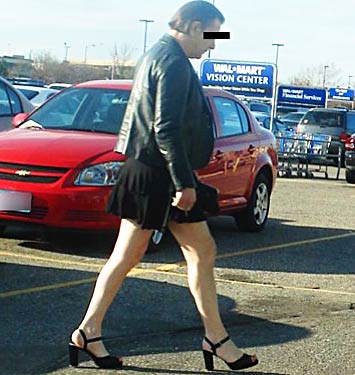 |
Cross-dressing is the wearing
of clothing and other accoutrement commonly associated with the other
gender within a particular society. Cross-dressing has been used
for disguise, performance art and as a literary trope in modern times
and throughout history. Nearly every human society throughout history has distinguished between male and female gender by the style, color, or type of clothing they wear and has had a set of norms, views, guidelines, or even laws defining what type of clothing is appropriate for each gender. Cross-dressing runs significantly counter to those norms and, therefore, can be seen as a type of transgender behavior. It does not, however, necessarily indicate transgender identity; a person who cross-dresses does not always identify as being of the opposite gender. |
 |
Paisley or Paisley pattern is a droplet-shaped
vegetable motif of Indian and Persian origin, similar to half of the
Yin yang symbol. The pattern is sometimes called "Persian pickles"
by American traditionalists, especially quiltmakers, or "Welsh
pears" in Welsh textiles as far back as 1888. Resembling a twisted teardrop, the kidney-shaped paisley is Persian and Indian in origin, but its western name derives from the town of Paisley, in central Scotland. |
 |
Tie-dye is a process of resist dyeing textiles
or clothing which is made from knit or woven fabric, usually cotton;
typically using bright colors. It is a modern version of traditional
dyeing methods used in many cultures throughout the world. "Tie-dye" can also describe the resulting pattern or an item which features this pattern. Tie-dying became fashionable in the West in the late 1960s and early 1970s as part of hippie style. It was popularized in the United States by musicians such as John Sebastian, Janis Joplin, and Joe Cocker. |
 |
Since over the knee boots have been a trendy
item this season, you can wear them with a lot of things and get away
with it. You might not be so lucky next year or the year after, so take
advantage of their immense popularity and wear them with everything
you can. Obvious choices are of course dresses or skirts that fall about 1-3 inches above the top of the boots (or about 4 inches from the top of your knee cap.) Wear tights, leggings or thigh high socks in a complimenting color. You can also tuck your skinny jeans or Ponté Knit Pants into your over the knee boots. |
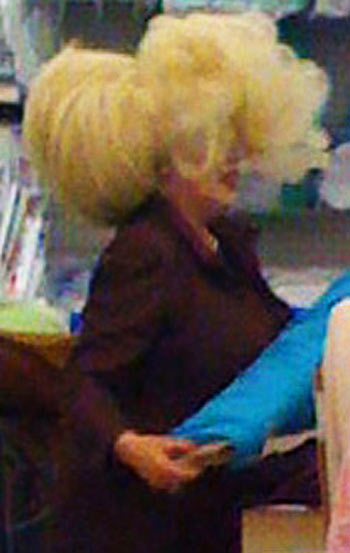 |
Whether theatrical, ceremonial, or fashionable,
wigs are always a pleasure not only to wear, but also to behold. In ancient Egypt the wig was worn to protect the head from the sun; short-haired and in many tiers or long and thickly plaited, the wig was an ingenious structure and rather formalized in appearance. Roman women, who favored light hair, often wore blond wigs. The wig came into popular fashion in Europe in the 17th cent. First worn in France during the reign of Louis XIII, who himself wore a wig of long curls that was meant to simulate real hair, the fashion became widespread during the reign of Charles II of England. As human hair was both difficult to obtain and expensive, the hair of horses and goats was often used. |
 |
The bikini is a women's swimsuit, usually
with two parts, one covering the breasts, the other the groin (and optionally
the buttocks), leaving an uncovered area between the two (optionally
in the case of the Tankini). It is often worn in hot weather or while swimming. The shapes of both parts of a bikini resemble women's underwear, and the lower part can range from revealing thong or g-string to briefs and modest square-cut shorts. Merriam–Webster's Collegiate Dictionary describes the bikini as "a woman's scanty two-piece bathing suit", "a man's brief swimsuit" and "a man's or woman's low-cut briefs". Predecessors of the bikini, which shocked when it appeared on French beaches in 1947, dates back to antiquity, in Çatalhöyük and the Greco-Roman world. The modern bikini was invented by French engineer Louis Réard in 1946. He named it after Bikini Atoll in the Pacific, the site of the Operation Crossroads nuclear weapon tests in July that year. |
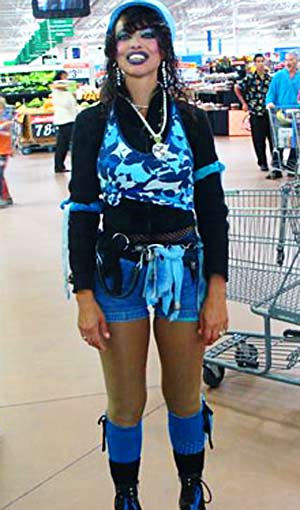 |
Cyan may be used as the name of any of a number
of colors in the blue/green range of the spectrum. In reference to
the visible spectrum cyan is used to refer to the color obtained by
mixing equal amounts of green and blue light or the removal of red
from white light. As such, cyan is the complement of red in RGB and
CMYK color models: cyan pigments absorb red light. |
 |
The intergluteal cleft, also known as the
natal cleft or more commonly in the US, the butt crack, is the groove
or crack between the buttocks that runs from just below the sacrum to
the perineum, so named because it forms the visible border between the
external rounded protrusions of the Gluteus maximus muscles. The intergluteal
cleft is located directly above the anus. The gluteal muscles are the three muscles that make up the buttocks: the gluteus maximus muscle, gluteus medius muscle and gluteus minimus muscle. The gluteus maximus is the largest of the gluteal muscles and one of the strongest muscles in the human body. It inserts at the iliotibial band and the gluteal tuberosity of the femur. Its action is to extend and outwardly rotate hip, and extend the trunk. Strength training exercises which are known to significantly strengthen the gluteus maximus include the squat and the deadlift. The leg press also uses the gluteus maximus. |
 |
Formal dress (UK) and formal wear (US/Canada)
are the general terms for clothing suitable for formal social events,
such as a wedding, formal garden party or dinner, débutante cotillion,
dance, or race. The Western style of formal evening
dress, characterized by black and white garments, has spread through
many countries; it is almost always the standard formal social dress
in countries without a formal national costume. A dress code is a set of rules governing a certain combination of clothing; some examples are black tie and morning dress. Formal dress is the grouping of all the dress codes which govern clothes worn to formal events. The traditional rules that govern men's formal dress are strictly observed; from these derive the evening dress variants worn on many occasions, such as high school prom dances, formal dances, and entertainment industry award programs. |
 |
Clowns are joyous, comical performers, stereotypically characterized
by their grotesque appearance: colored wigs, stylistic makeup, outlandish
costumes, unusually large footwear, red-nose, etc., who entertain spectators
by acting in a hilarious fashion. The types of their acts varies greatly. Although some find clowns to be scary, their intended purpose is to entertain people, especially young children. Peter Berger writes that "It seems plausible that folly and fools, like religion and magic, meet some deeply rooted needs in human society." For this reason, clowning is often considered an important part of training as a physical performance discipline, partly because tricky subject matter can be dealt with, but also because it requires a high level of risk and play in the performer. Clowning was developed from a broad tradition of historical performances, and it is difficult to point out a singular tradition or even a few different ones as being the primary precursors to clowns. However there are a few past prominent forms of entertainment contemporarily linked to clowning as its possible antecedents. It is important to note that a whiteface character does not always wear the classic whiteface makeup. Additionally, a character can wear traditional whiteface makeup and be an auguste. |
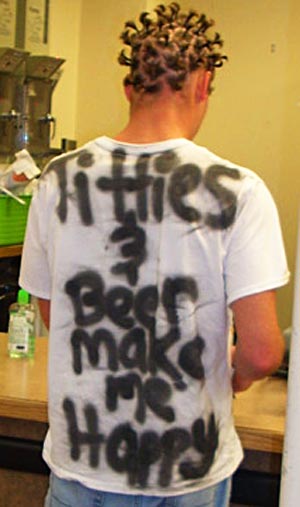 |
Graffiti (singular: graffito; the plural
is used as a mass noun) is the name for images or lettering scratched,
scrawled, painted or marked in any manner on property. Graffiti is any
type of public markings that may appear in the forms of simple written
words to elaborate wall paintings. Graffiti has existed since ancient times, with examples dating back to Ancient Greece and the Roman Empire. In modern times, spray paint, normal paint and markers have become the most commonly used materials. In most countries, defacing property with graffiti without the property owner's consent is considered vandalism, which is punishable by law. Sometimes graffiti is employed to communicate social and political messages. To some, it is an art form worthy of display in galleries and exhibitions; to others it is merely vandalism. Graffiti has since evolved into a pop culture existence often related to underground hip hop music and b-boying creating a lifestyle that remains hidden from the general public. Graffiti is used as a gang signal to mark territory or to serve as an indicator or "tag" for gang-related activity. There are many different types and styles of graffiti and it is a rapidly developing artform whose value is highly contested, being reviled by many authorities while also subject to protection, sometimes within the same jurisdiction. |
 |
The Thong is a garment worn either as underwear
or as a swimsuit by both women and men. The garment from the front can
look like a regular bikini bottom, but on the back the material that
holds the front up is reduced to a minimum. The back of the garment typically consists of a thin waistband and a thin strip of material that runs from the waistband under the crotch to join up with the bottom front of the garment, and typically designed to sit between the wearer's buttocks. One type of thong is the g-string or T-back, the back of which consists only of an elastic string. The two terms g-string and thong are often used interchangeably; however, they can refer to distinct pieces of clothing. See design and variety of thongs for details. Thongs come in a variety of styles depending on the thickness, material, or type of the rear portion of fabric and are available for both men and women throughout most of the world. The thong is known as fio dental (literally dental floss) in Brazil. |
 |
Advertising is a form of communication intended
to persuade an audience (viewers, readers or listeners) to take some
action. It includes the name of a product or service and how that product
or service could benefit the consumer, to persuade potential customers
to purchase or to consume that particular brand. Modern advertising
developed with the rise of mass production in the late 19th and early
20th centuries. Commercial advertisers often seek to generate increased consumption of their products or services through branding, which involves the repetition of an image or product name in an effort to associate related qualities with the brand in the minds of consumers. Non-commerical advertisers that spend money to advertise items other than a consumer product or service include political parties, interest groups, religious organizations and governmental agencies. Nonprofit organizations may rely on free modes of persuasion, such as a public service announcement. |
 |
A T-shirt (or tee shirt) is a shirt which
is pulled on over the head to cover most of a person's torso. A T-shirt
is usually buttonless and collarless, with a round neck and short sleeves.
However, many people use the term T-shirt to describe any short sleeved
shirt or blouse. The sleeves of the T-shirt extend at least slightly
over the shoulder but not completely over the elbow (in short-sleeve
version). A shirt that is either longer or shorter than this ceases
to be a T-shirt. T-shirts are typically made of cotton or polyester
fibers (or a mix of the two), knitted together in a jersey stitch that
gives a T-shirt its distinctive soft texture. T-shirts can be decorated
with text and/or pictures, and are sometimes used to advertise (see
human billboard). |
 |
Childcare, child care, or babycare is the
act of caring for and supervising children from 0-16 years of age. (In
the UK and Australia, day care is referred to as "childcare".)
In the united States child care is increasingly referred to as early
care and education or early childhood education due to the understanding
of the impact of early experiences of the developing child. Child care is a broad topic covering a wide spectrum of contexts, activities, social and cultural conventions, and institutions. |
 |
The curvature of the female back is a frequent
theme in paintings, because the sensibilities of many cultures permit
the back to be shown nude - implying full nudity without actually displaying
it. Indeed, the practice of showing explicitness on the lower back has
been performed for centuries. Certain articles of clothing, such as
the haltertop and the backless dress, are designed to expose the back
in this manner. The back also serves as the largest canvas for body
art on the human body. Because of its size and the relative lack of
hair, the back presents an ideal canvas on the human body for lower
back tattoos. Indeed, some individuals have tattoos that cover the entirety
of the back. Others have smaller tattoos at significant locations, such
as the shoulder blade or the bottom of the back. |
 |
Big hair is a term that can refer to hairstyles
that emphasize large volume or largely styled hair. Big hair was popular
in the 1980s. The term is also used in the punk, glam, goth and alternative
cultures and is particularly associated with fashion of the 1980s, or
inspired by the period. Less commonly, big hair can refer to any style that incorporates a great deal of height and/or volume. Depending on the specific style, hairstyles in the big hair categories may require a number of styling, cutting, or treatment techniques. Styling of punk and alternative big hair styles often requires backcombing (teasing) and the liberal application of styling aids such as hair spray and hair gel, often in combination with the use of hair dryers. Crimping irons, perms, hair rollers, or other techniques may also be required. |
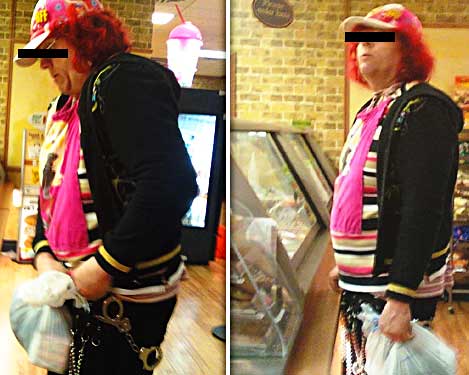 |
The Eccentric Club was the name of several
London gentlemen's clubs, the best-known of which existed between 1890
and 1986. For much of its history it was based at 11 Ryder Street, St
James's. The first Eccentric Club had its roots in the Society of Eccentrics which existed in 1781-1820s and was later renamed into The Eccentric Society Club which finally dissolved in 1846. It existed at several addresses around Covent Garden. The third and longest-lived Eccentric Club was established by the theatrical costumier Jack Harrison in November 1890 and disbanded in 1986. Immediately upon its foundation, it occupied the upper floors of 21 Shaftesbury Avenue. In 1914, the club moved to the former Dieudonné's Hotel at 9-11 Ryder Street, where it remained until its closure. |
 |
Leg warmers are coverings for the lower legs,
similar to socks but thicker and generally footless. Leg warmers were
originally dancewear worn by ballet and other classic dancers. Leg warmers
are worn by some dancers to warm the lower calf, but others doubt their
usefulness. Traditionally knitted from pure wool, leg warmers are more typically made of cotton, synthetic fibers, or both. Some are made of other materials, such as chenille. Other leg warmers are made of wool, camel hair and Old English Sheep Dog hair. Leg warmers were originally worn by dancers to keep their muscles from cramping after stretching, but in the early 1980s, leg warmers became a fad, and wearing them was fashionable among teenage girls. Their popularity was partly due to the influence of the films Fame and Flashdance and the concurrent aerobics craze. They were worn with leggings, jeans, and tights or as part of aerobic wear. KD dance the New York City based high end dance wear company created by dancers Tricia Kaye and David Lee were one of the first to introduce knit leg and arm warmers as a fashion item back in the 80's. To date KD dance estimates sales of over 50 million pairs of Leg Warmers since their inception in 1980. According to fashion types Leg Warmers had retreated back into relative obscurity by 1989, although they were still widely used by dancers. |
